Recent Articles
Popular Makes
Body Types
2017 Honda Civic: Pros and Cons
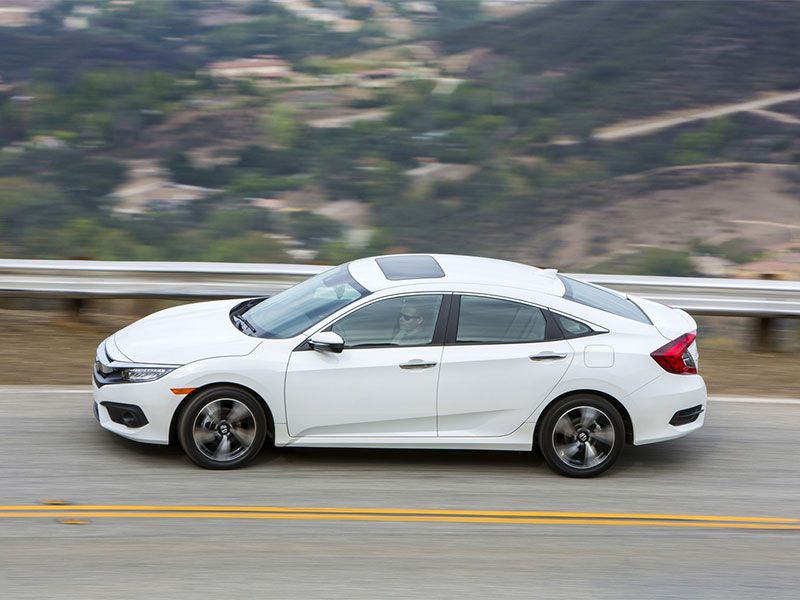
2017 Honda Civic Sedan profile ・ Photo by Honda
The list of pros and cons for the 2017 Honda Civic is heavily tilted toward the former, as the popular compact remains a top choice. In fact, when the 10th-generation Honda Civic sedan made its debut, it was named the 2016 North American Car of the Year while also racking up numerous other honors. Since then, two more Civic body styles have been introduced, and also keep your eyes out for the first U.S. version of the high-performance Civic Type R, which is expected in 2017. The new Civic has high levels of safety technology, too, with ratings to match. Yet no car is perfect. Let’s take a look at the pros and cons for the 2017 Honda Civic.
Pro: Three Body Styles
Let’s start by looking at the 2017 Honda Civic lineup: While most mainstream brands have sedan and hatchback entries in the compact segment, Honda stands out by also offering a coupe. Those three body styles add up to a definite advantage, as they can appeal to a wider range of customer tastes: The coupe is particularly sporty and has been restyled from the A-pillars rearward—as compared to the sedan—and the hatch adds a versatile rear cargo area that can hold 25.7 cubic feet behind the rear seats and 46.2 cubic feet in total. As for the sedan, it’s bigger but lighter than the previous-gen model it replaced, with more power and better fuel efficiency.
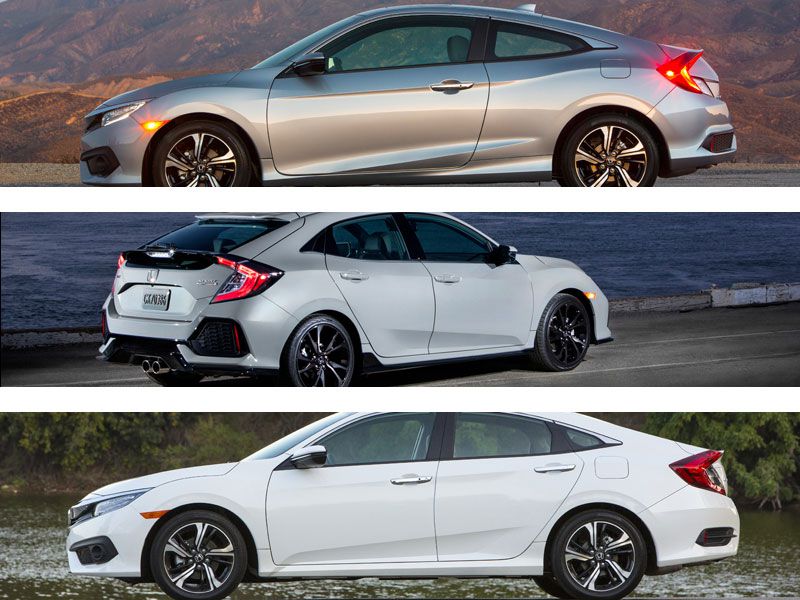
Photo by Honda
Con: Premium Pricing
Cost is an important factor when looking at a car such as the 2017 Honda Civic. The price of admission here is a bit higher than for other mainstream compacts. True, some of this is based on content. The Honda Civic sedan, for instance, counts a multi-angle rearview camera, automatic climate control, power amenities, and LED taillight accents as standard features. Yet it also has an MSRP of $18,740. That’s $340 above a Toyota Corolla; rival compact sedans from Chevy, Ford, Hyundai, and Nissan all start below $17,225. Similarly, Honda’s hatch opens at $19,700, which is higher than for rivals from Ford, Hyundai, Mazda, and Toyota. It’s not that the Civic isn’t worth it; it’s that there’s no basic budget entry in the lineup.
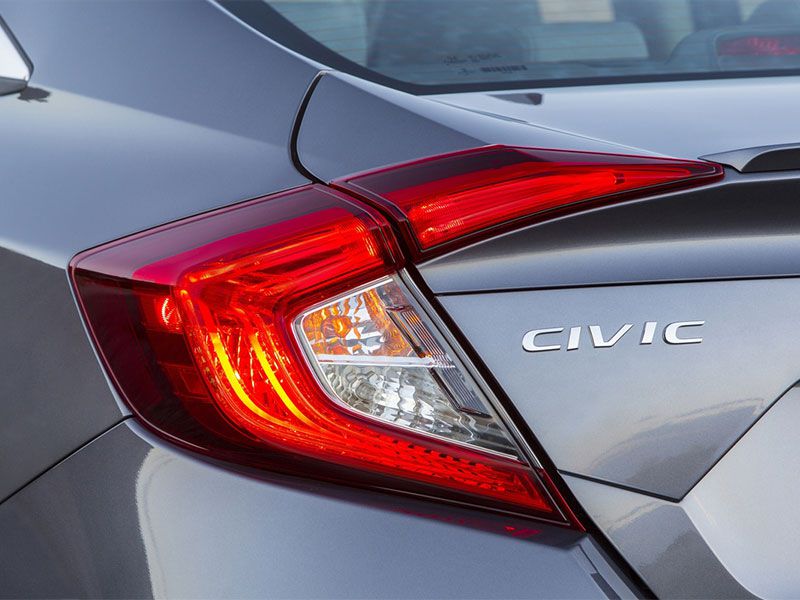
Photo by Honda
Pro: Highly Efficient Powertrains
Let’s look at fuel economy. The new Honda Civic actually leads the way for 2017 compact sedans, courtesy of EPA figures as high as 32 MPG city/42 MPG highway/37 MPG combined (with a 1.5-liter turbo engine and continuously variable transmission). Yet even the standard powertrain for the sedan—a 2.0-liter naturally aspirated 4-cylinder engine with a 6-speed manual transmission—is good for an EPA line of 28/40/32. The more athletically oriented, turbo-only hatchback has fuel-efficiency marks of 31/40/34 with a CVT—or 30/39/33 with the manual transmission. Finally, rounding out the Civic roster is the coupe that boasts EPA ratings of 30/41/35 in its turbo/manual configuration.

Photo by Honda
Con: No Traditional Automatic Transmission
Despite impressive fuel-efficiency and output ratings, the 2017 Honda Civic does have two powertrain drawbacks: No traditional automatic transmission is available, and the brand doesn’t even try to fake manual-style shifting with paddles. That said, the Civic’s two CVTs—there are different versions for the naturally aspirated and turbocharged engines—leverage Honda’s next-generation “G-design shift logic.” This is engineered to provide a more conventional driving experience than is offered by typical CVTs, while also giving the Civic “more immediate acceleration response” than with a CVT or a regular automatic. A standard CVT Sport mode adjusts operation for more athletic endeavors, while an L mode mimics a low driving gear by supplying added engine-braking.
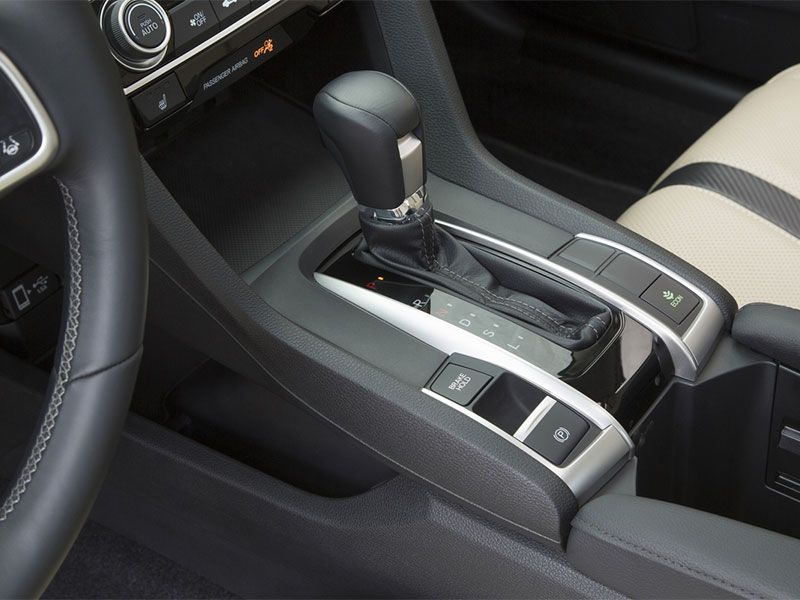
Photo by Honda
Pro: Performance and Power
The entry engine for the 2017 Honda Civic is the most powerful base unit ever fitted to the model, and its 158 horsepower and 138 lb.-ft. of torque are more than you’ll find in rivals from Toyota, Nissan, Chevy, and Hyundai, among others. Next up is the first turbocharged engine offered for a Civic. It’s a 1.5-liter 4-cylinder engine that serves up 174 horsepower and 162 lb.-ft. of torque. Moreover, Honda is catering to enthusiasts by supplying a 6-speed manual transmission with the turbo engine for the 2017 model year—and furnishing an extra 5 lb.-ft. of torque for that setup.
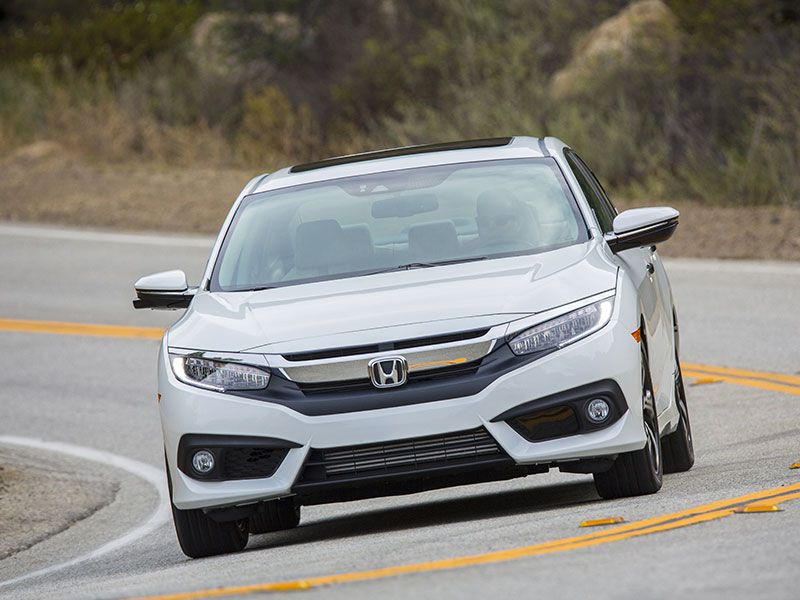
Photo by Honda
Pro: Excellent Safety
Although the IIHS has yet to test the 2017 Honda Civic Hatchback, the Civic coupe and Civic sedan have been recognized with 2016 Top Safety Pick+ certification—bolstered by the best possible crashworthiness and front crash-prevention technology—and all three body styles have 5 Star Overall Safety Scores from the NHTSA. A multi-angle rearview camera and expanded-view driver’s mirror are standard, while Honda LaneWatch and a bundle of Honda Sensing driver-assistance measures are all available. The Honda Sensing package is especially noteworthy, since it brings together collision mitigation braking, forward collision warning, lane-departure warning, road-departure mitigation, lane-keeping assistance, and more.
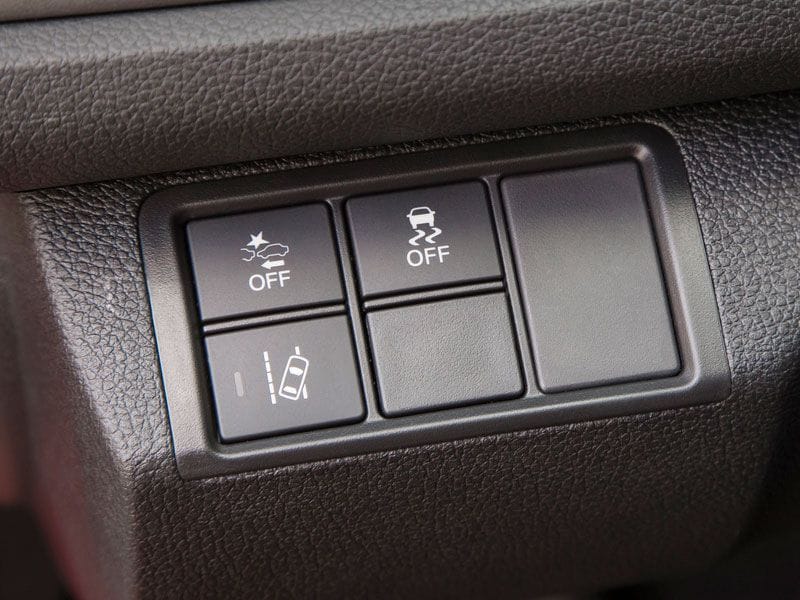
Photo by Honda
Con: Higher Insurance Costs
Another con: Insurance rates for the 2017 Honda Civic are likely to be a little bit higher than for compact rivals from the U.S. brands. That was the case in the 2016 model year, the last one for which complete data is currently available from Insure.com. Using those numbers, annual rates for the Chevy Cruze, Ford Focus, and Dodge Dart sedans could be $30 to $50 less expensive, on average, than a comparably trimmed Civic.
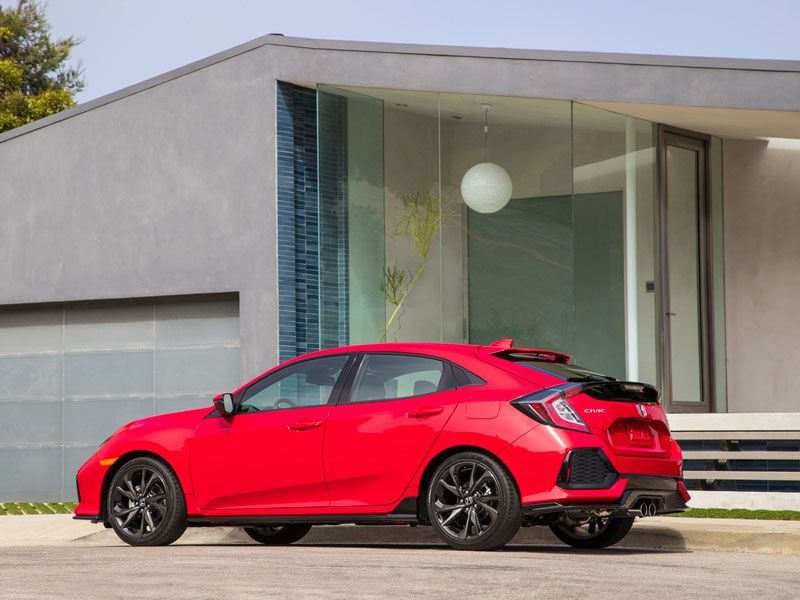
Photo by Honda
Cons: No Mobile Wi-Fi
One technology we wish the 2017 Honda Civic had: a mobile Wi-Fi hotspot with 4G LTE connectivity, which is a highlight of the Chevy Cruze. Now, the Cruze is the only mainstream compact with that service, and the Civic’s smartphone integration does mitigate the lack of Wi-Fi somewhat. However, when you’re targeting the top of the segment, like the Civic does, this has to be considered a con. The Civic’s 7-inch touchscreen is down an inch to the Cruze’s top screen as well, and when configured with that screen, the Honda’s infotainment system doesn’t have traditional audio knobs.
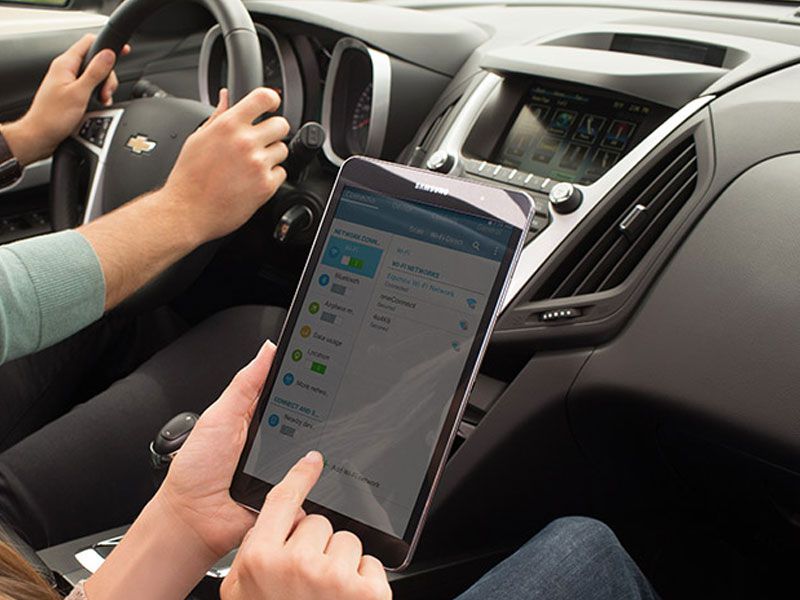
Photo by General Motors
Pro: Lots of Great Infotainment
Apart from the lack of Wi-Fi, the 2017 Honda Civic does showcase plenty of high-tech infotainment resources. For example, Android Auto and Apple CarPlay smartphone integration are standard for EX trims and above, and the same holds true for a 7-inch display-audio touchscreen, compatibility with Pandora audio streaming, and HondaLink connectivity. Upper Civic trims, meanwhile, can be fitted with a Satellite-Linked Navigation System that’s supported by HD Digital Traffic service, 3D rendering and voice recognition, including Honda Song By Voice functionality. As a bonus for audiophiles, the Civic’s standard 160-watt sound system can be augmented by a 10-speaker setup with 450 watts of power.
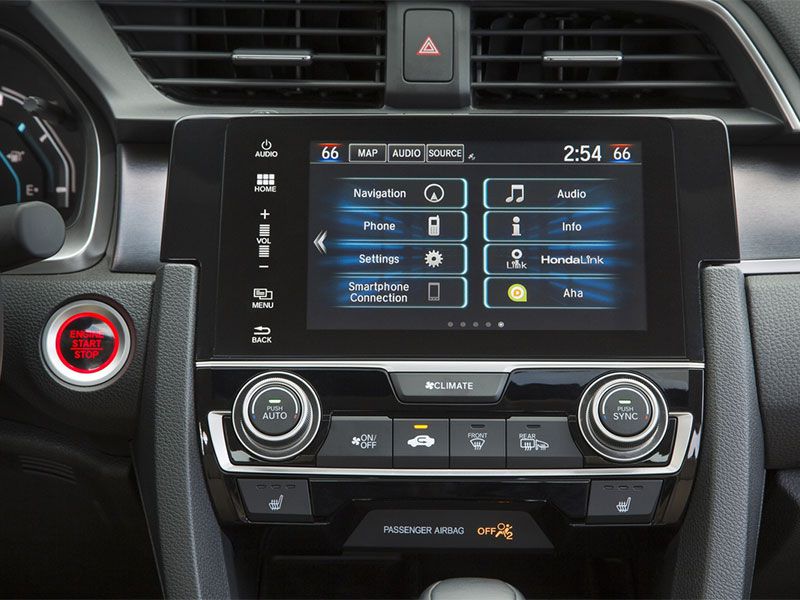
Photo by Honda
Our Verdict
Finding cons for the 2017 Honda Civic isn't easy. The Civic lineup has been well received, thanks to its stylish appearance, its long list of infotainment and driver-assistance technologies, and its strong EPA and safety ratings. And that’s without considering the Civic’s available luxuries. Multi-stage heating is available for the driver and front-row passenger, and it also can be ordered for the outboard second-row occupants. LED lighting (with LED headlights) is also available. The Civic earned Autobytel’s Compact Car of the Year award last year, and it remains one of our favorites.
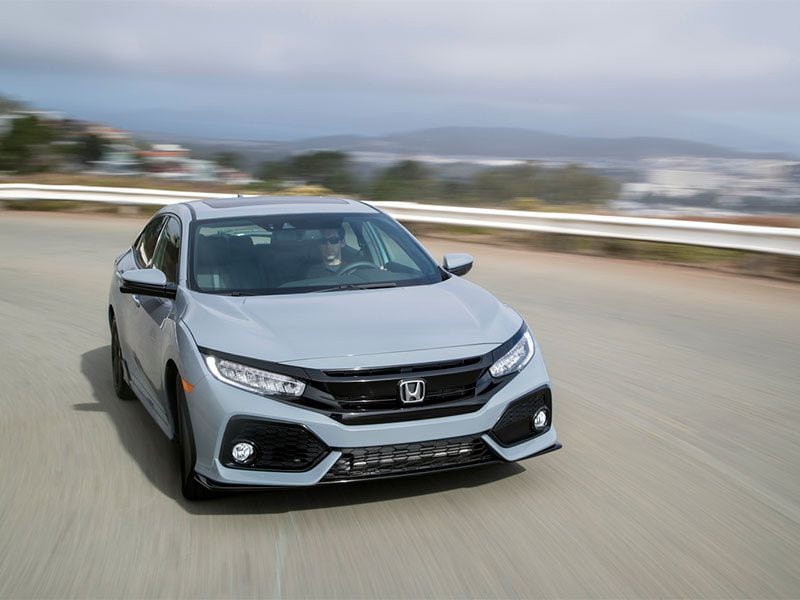
Photo by Honda